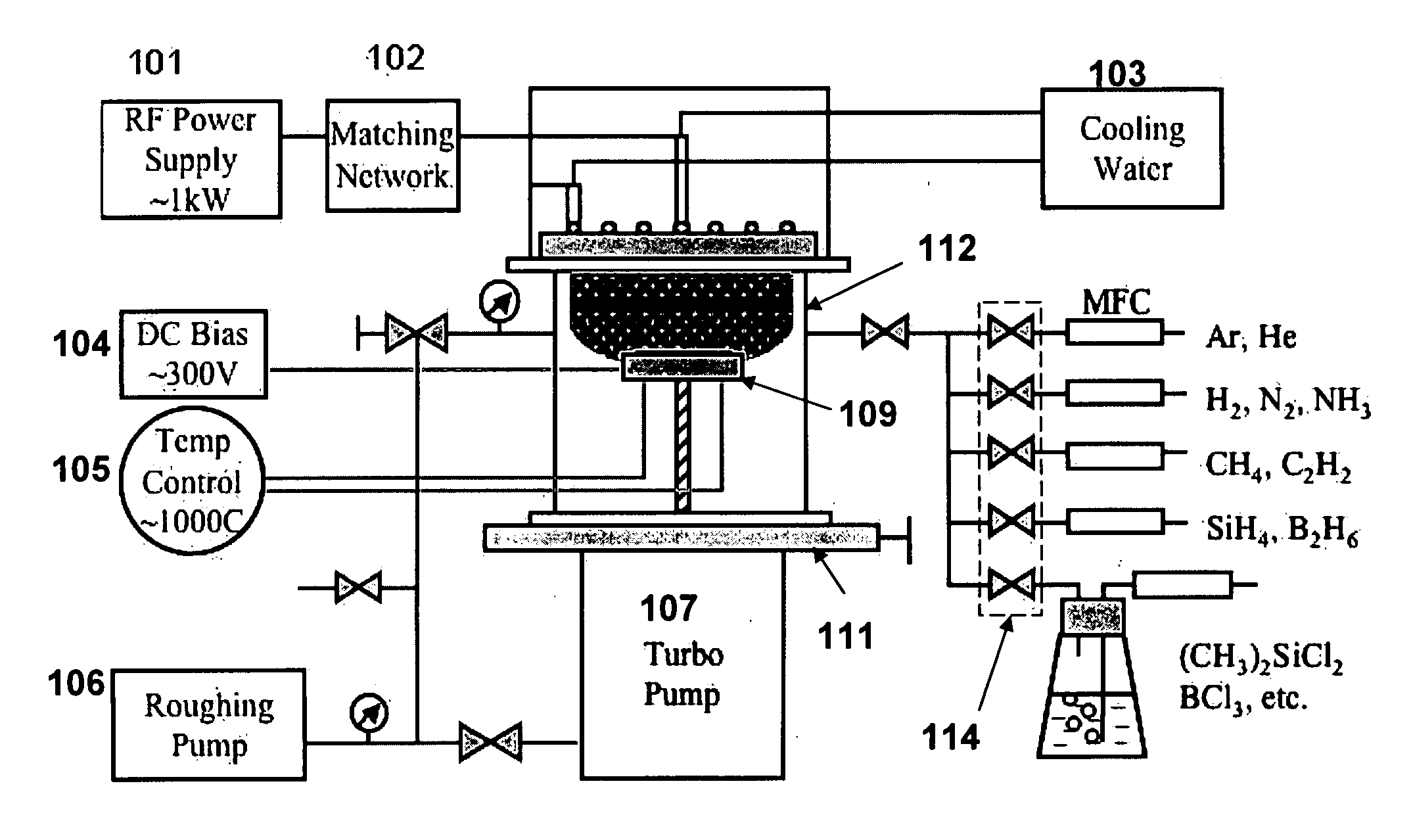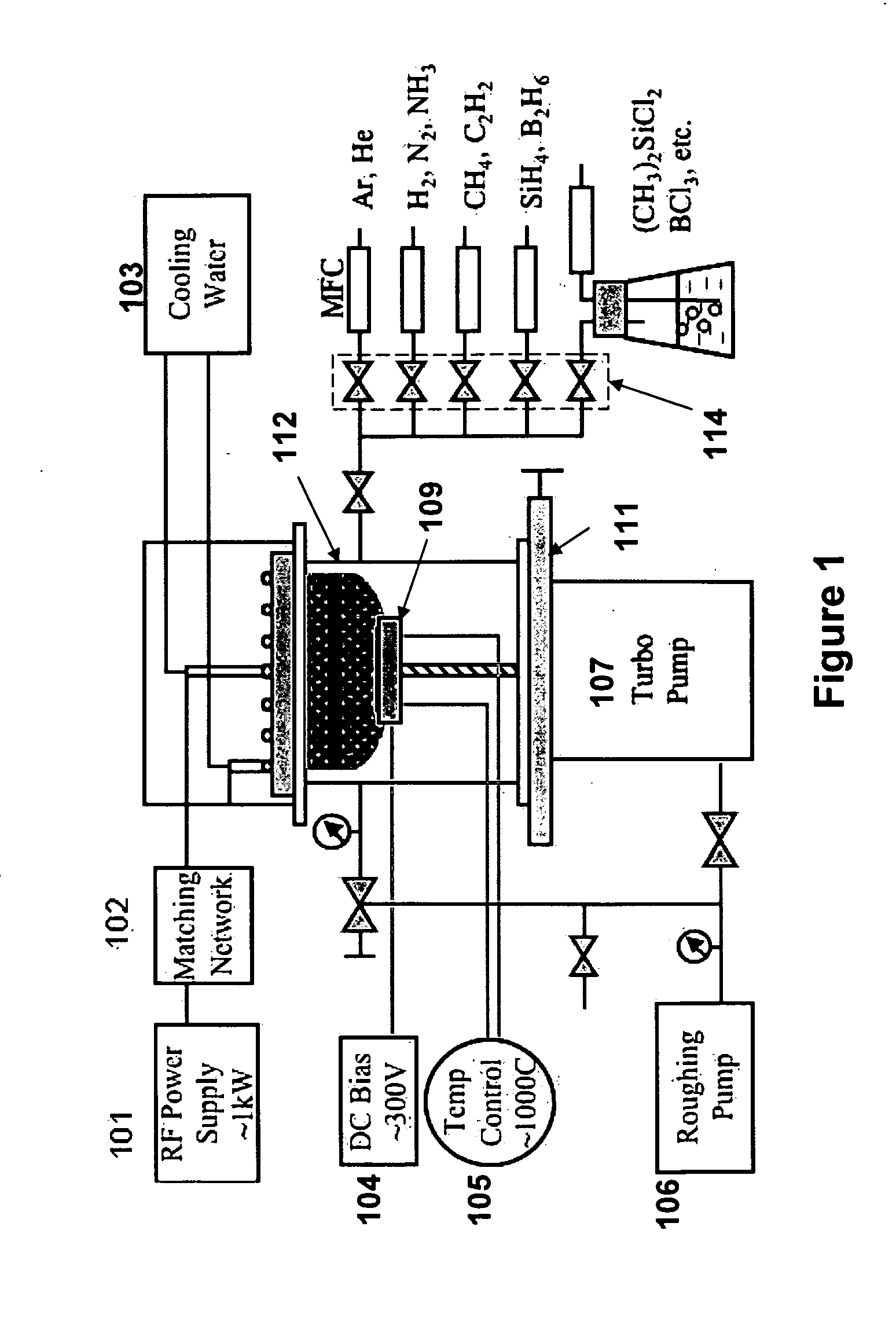Coated carbon nanoflakes
a carbon nanosheet and coating technology, applied in the manufacture of electrode systems, non-metal conductors, electric discharge tubes/lamps, etc., can solve the problems of reducing the local field enhancement factor and the field emission performance of carbon nanosheets, and achieve the effect of improving the effect of electron emission of carbon nanoflakes coated with low z compound
- Summary
- Abstract
- Description
- Claims
- Application Information
AI Technical Summary
Benefits of technology
Problems solved by technology
Method used
Image
Examples
example 1
Synthesis of CrOx—CNS
[0054]A four-inch, heavily-doped Si wafer (resistivity of 0.003-0.005 Ω·cm) was loaded on the sample stage (109 as shown in FIG. 1), and the RF-PECVD apparatus was pumped down to 1 mTorr. Hydrogen gas was first introduced into the system at 6 sccm while the substrate was heated up to approximately 700° C., at which temperature it was held for approximately 30 minutes to ensure uniform heating. Then, CH4 was added to the chamber at 4 sccm and the apparatus pressure was stabilized at approximately 100 mTorr. An RF plasma was ignited and tuned as the power was increased to 900 W over the course of about one minute. Deposition was conducted for 20 minutes. The apparatus was cooled down for at least 30 minutes in a hydrogen atmosphere before the sample was taken out.
[0055]The as-grown CNS samples were placed in a vacuum evaporator, and a chromium layer was subsequently evaporated on the surface of the CNS. A tungsten wire twisted into a conical shape was applied as t...
example 2
Characterization of CrOx—CNS
[0056]Elemental analyses of as-grown CNS and CrOx—CNS were conducted by Energy Dispersive X-ray (EDX) analysis accompanied with SEM images. Carbon nanosheets were coated with chromium oxide using 15 seconds evaporation time according to the method of Example 1. FIG. 2a shows the elemental distribution profile extracted from the EDX survey across the sample area of as-grown CNS seen in the SEM image (inset). Peaks associated with C and Si are observed in the profile. The Si peak originates from the substrate on which nanosheets grow and the C peak comes from the CNS. No other elements are detected within this sample area. In contrast to as-grown CNS, the EDX spectrum of CrOx—CNS shown in FIG. 2b not only has peaks associated with C and Si, but also has peaks corresponding to Cr and O, confirming the formation of chromium oxide coating on CNF.
[0057]FIG. 3 shows an Auger spectrum of CrOx—CNS fabricated using 10 seconds chromium evaporation time according to ...
example 3
Field Emission Properties of CrOx—CNS with 15 nm Chromium Oxide Coating
[0060]To directly compare the field emission performance of CrOx—CNS and as-grown CNS, patterned CrOx—CNS samples were used for PEEM and FEEM observations. PEEM captures both photoelectrons generated by the photon source and field emission electrons extracted by the applied electric field to form images while FEEM only uses field emission electrons for imaging with the absence of photon source in PEEM. The contrast information of PEEM and FEEM images yields the spatial distributions of electron source in the sample and thereby determines the emission uniformity of the sample. Patterned CrOx—CNS samples were fabricated by using an evaporation time of 10 seconds through a TEM grid that was placed over as-grown CNS samples, resulting in a sample consisting of alternating CrOx—CNS squares and as-grown CNS streets. PEEM systems operating at pressures on the order of ˜10−8 Torr were used to conduct these observations w...
PUM
| Property | Measurement | Unit |
|---|---|---|
| thickness | aaaaa | aaaaa |
| thickness | aaaaa | aaaaa |
| thickness | aaaaa | aaaaa |
Abstract
Description
Claims
Application Information
 Login to View More
Login to View More - R&D
- Intellectual Property
- Life Sciences
- Materials
- Tech Scout
- Unparalleled Data Quality
- Higher Quality Content
- 60% Fewer Hallucinations
Browse by: Latest US Patents, China's latest patents, Technical Efficacy Thesaurus, Application Domain, Technology Topic, Popular Technical Reports.
© 2025 PatSnap. All rights reserved.Legal|Privacy policy|Modern Slavery Act Transparency Statement|Sitemap|About US| Contact US: help@patsnap.com



